Menu
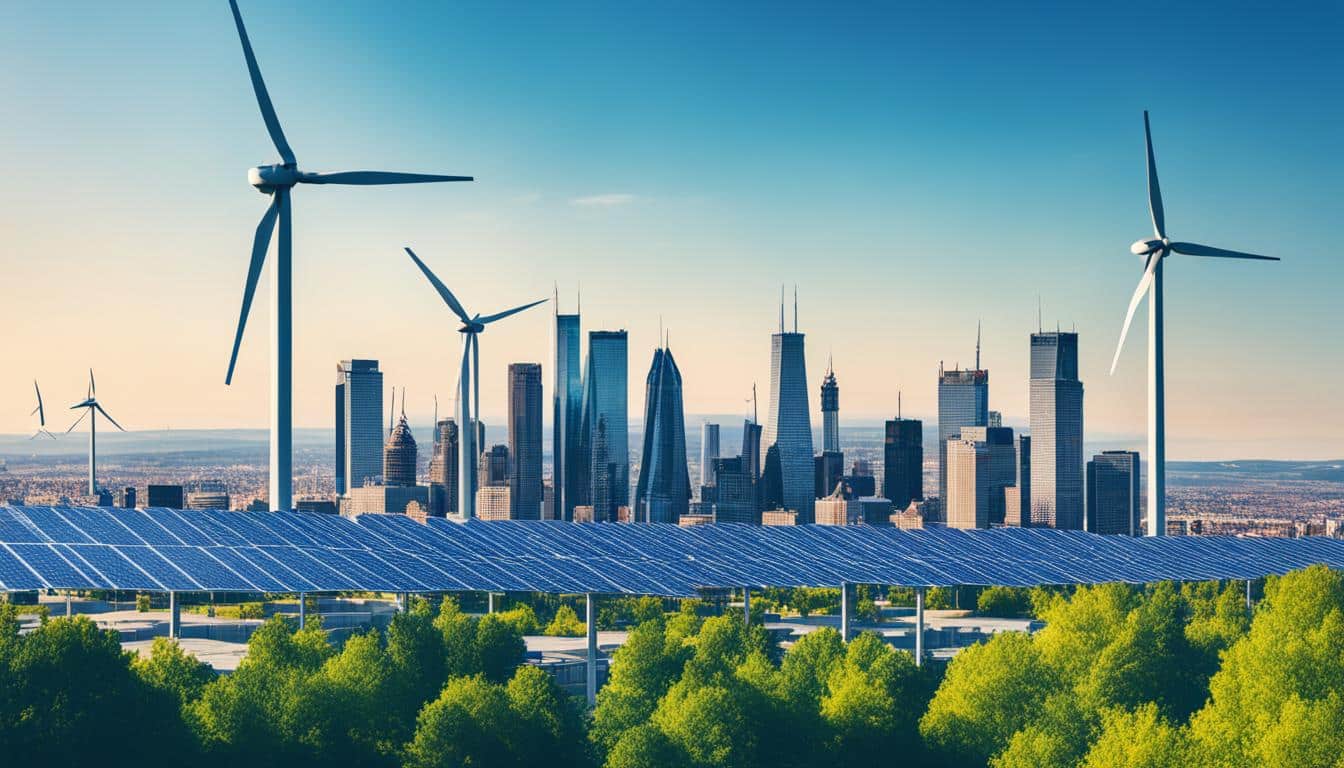
Wind power emits only 0.02 to 0.04 pounds of carbon dioxide equivalent per kilowatt-hour (CO2E/kWh) on a life cycle basis. This is a lot less than what fossil fuels produce. It shows how important renewable energy policies are in the United States. These policies help deal with about 29 percent of the world’s global warming emissions from making electricity. As the US focuses more on renewable energy, new laws are making big changes. These laws aim for cleaner energy and better care of the environment.
The US has seen big steps in making clean power. By 2023, there are many achievements in solar energy, better batteries, and more electric cars being sold. This shows a serious promise to use greener power ideas. Important laws such as the Inflation Reduction Act, Bipartisan Infrastructure Law, and CHIPs Act are helping. But, the high cost of projects, troubles in getting supplies, and challenges with rules are difficult. Overcoming these challenges is key to keeping the push for a cleaner future going strong.
The future looks bright for renewable energy in the US. But, making it work will need constant hard work and strong, clear rules. By pushing through the current challenges, the US could lead in building a greener, sustainable future.
In the United States, there are policies to boost the use of green energy like solar and wind power. The aim is to help these types of energy grow. This includes giving financial help and making rules that support green energy. The focus is on spreading green energy tech all over America.
Green energy guidelines in the US help move us towards a cleaner, more sustainable energy future. These guidelines offer things like tax breaks to help all kinds of clean energy projects. They also help add these new energies to the overall electrical system. Thanks to these efforts, wind and solar power have become much cheaper. Now, they cost less than energy from gas or coal.
Renewable energy laws play a huge role in cutting down on harmful emissions. This is vital to stop the negative effects of climate change. Plus, they lessen the need for oil and gas, which makes the country more independent. By investing in clean energy, we also boost our economy. In 2022, the US clean energy market was worth $269 billion. This shows the big financial impact of these laws.
Offshore wind energy development is important for the US’s green energy plans. It must be done carefully, from choosing the right spots to building and eventually taking things apart. States have also done a lot to push for more renewable energy. About half of the growth in US green energy since 2000 is thanks to state rules.
The United States has recently passed some key laws for clean energy. These include the Inflation Reduction Act, Bipartisan Infrastructure Law, and CHIPs Act. These laws play a big role in promoting green energy. They support the move to low-carbon energy sources.
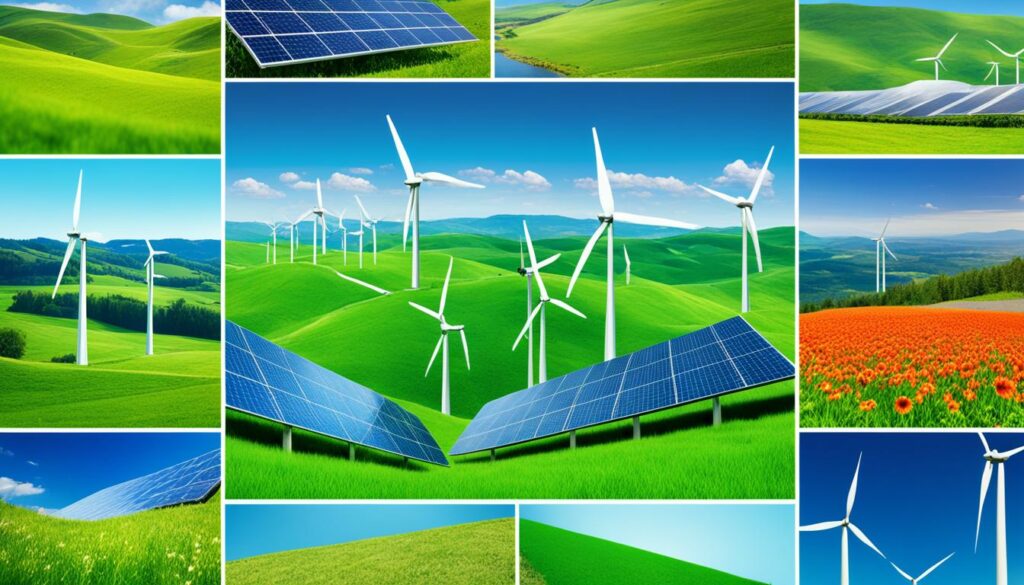
The Inflation Reduction Act supports eco-friendly energy projects. It encourages investment in clean energy. Plus, it gives tax breaks to help cut down on pollution. Thanks to this, we’ve seen more solar panels installed and better battery technology.
The Bipartisan Infrastructure Law is making the country’s essential systems up to date. It puts $7.5 billion towards making more electric vehicle (EV) charging points. This helps because more people are buying EVs, which is good for our planet. Also, it’s funding bigger energy storage, moving us towards greener energy.
The CHIPs Act is boosting clean energy tech made at home. This is cutting our need for energy parts from abroad. It’s investing heavily in places that build wind and solar technologies. The goal is to make it easier to get permission to build these energy systems.
| Legislation | Impact on Renewable Energy | Key Initiatives |
|---|---|---|
| Inflation Reduction Act | Record solar installations, investment in battery storage | Tax incentives, emissions reduction |
| Bipartisan Infrastructure Law | Expansion of EV charging networks, enhanced energy storage | NEVI program, support for infrastructure |
| CHIPs Act | Boost in domestic clean energy manufacturing | Investment in renewable energy technology |
In 2023, the US hit a big success in solar energy. They installed a record 31 gigawatts (GW) of solar power. This was 55% more than the year before. It shows that people are focusing more on green energy.
By the third quarter of 2023, solar energy made up half of the new large-scale power. There’s now a total of 161 GW in the US. This growth proves the US wants to use more solar energy in its plans for a greener future.
But, the solar industry isn’t without its problems. There have been issues with getting the right parts on time, making some projects late. For example, big transformers can take up to four years to arrive. Also, the end of certain tax breaks and rising loan rates mean the cost of solar projects is going up.
To solve these problems, it’s important to make things at home, like solar panels. This way, the US won’t have to rely on parts from other countries. Supporting new laws, like the Inflation Reduction Act, can also help a lot.
| Year | Solar Capacity Installed (GW) | Percentage Increase |
|---|---|---|
| 2022 | 20 | — |
| 2023 | 31 | 55% |
The progress in solar energy in 2023 is a big step towards greener power. It shows there’s more room to grow in the future.
Battery storage is now essential in the U.S. We’re seeing big growth and exciting predictions. By 2024, the amount of energy storage is set to double. This shows how important battery technology is for the move to cleaner energy. Laws like the Inflation Reduction Act are pushing for more use of renewable energy.
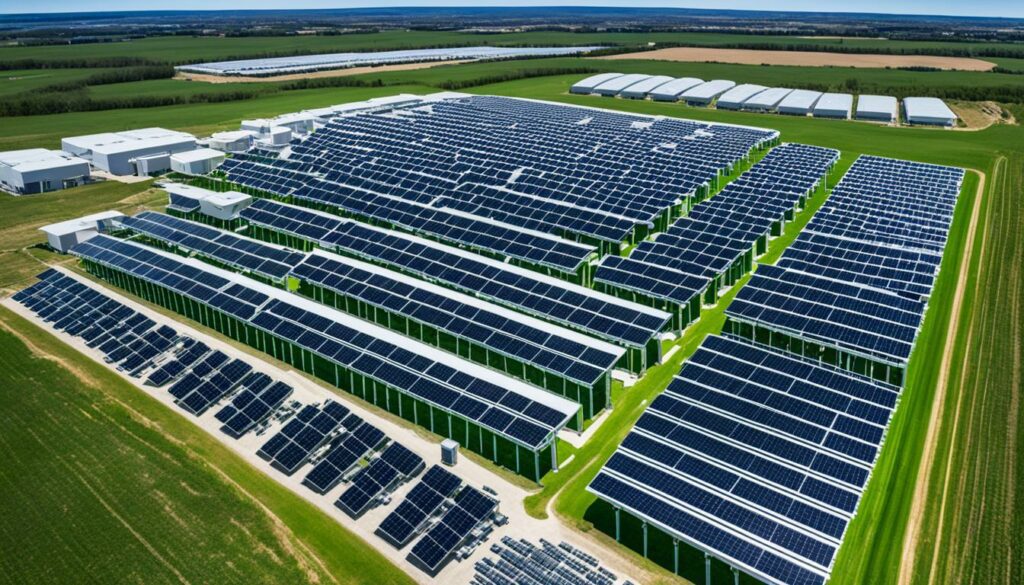
Last year, the U.S. added 6.4 GW of new battery storage. This was a 70% increase from the year before. Now, the country has about 8.8 GW of large-scale storage working. The plan is to add another 14.3 GW in 2024, showing very fast growth.
Most of the new storage will be in Texas and California. A big project in Riverside, California, is a 460.0 MW storage bank. Experts expect over ten times more storage by 2030. All this shows the big push for clean energy.
Battery storage is crucial for a steady, reliable power system as we use more renewable energy. It helps manage the ups and downs of solar and wind power. This way, we don’t rely too much on certain power plants, and we can use our power more smartly.
| Year | Battery Storage Capacity Added (GW) | Percentage Increase |
|---|---|---|
| 2023 | 6.4 | 70% |
| 2024 | 14.3 | Approx. 123% |
| 2030 | Projecting over 100 GW | More than tenfold from current |
Next year, the U.S. will see a big jump in new power with 62.8 GW added. Solar will make up most of this new power. Battery storage and offshore wind are also key parts of this growth plan. It’s all about making the switch to clean energy smoother and the power system stronger.
Wind energy has made big strides in the United States. By the third quarter of 2023, the country had 147 GW installed. While solar power grows faster, wind energy is key in making the US energy mix diverse. Thanks to supportive policies and new technology, its future looks bright.
Wind energy keeps getting better in recent times. One major change is in the wind turbines themselves. Today’s towers can stand at up to 90 metres, with rotors stretching up to 125 metres. This is a big jump from the 30-metre towers and rotors in the 1990s. The power these turbines can produce has also gone up, from 0.2 megawatts to 3 megawatts.
But these developments are not the end. The newest designs in wind turbines might even top the Washington Monument in height and have rotors of up to 150 metres. With towers at 160 metres, these designs will help wind energy stay in the lead.
| Attribute | 1990s | 2020s | Future Prospects |
|---|---|---|---|
| Tower Height | 30 metres | 90 metres | 160 metres |
| Rotor Diameter | 30 metres | 125 metres | 150 metres |
| Power Capacity | 0.2 MW | 3 MW | – |
The future looks bright for wind energy in the US. Making towers in new ways, like spiral welding and 3D printing, could cut costs. And using climbing cranes and wake steering may make wind power cheaper and more spread out. The National Renewable Energy Laboratory (NREL) thinks these steps could boost by up to 80% the amount of useful wind power in America.
This would benefit places like the Southeast, Gulf Coast, and parts of the East Coast. With new technology and rules, opening new areas to wind power aims to cut power bills and spread clean energy. This shows how important wind energy is for a green, low-carbon future.
By 2023, the electric vehicle (EV) market is booming, reaching a key point in sales. The influence extends across the United States, powered by growing legislative support and economic incentives. This wave of EV adoption brings hope for a cleaner future.
2023 saw a remarkable rise in EV sales. Despite worries of a slowdown, sales kept increasing, displaying a significant move to greener transport options. In 2020, global electric car sales surged 40% over the year before, despite an overall drop in car sales due to the pandemic.
Europe stood out, with sales growing by 55% in the first half of 2020. This growth was due to strong incentives in countries like Germany, France, and Italy.
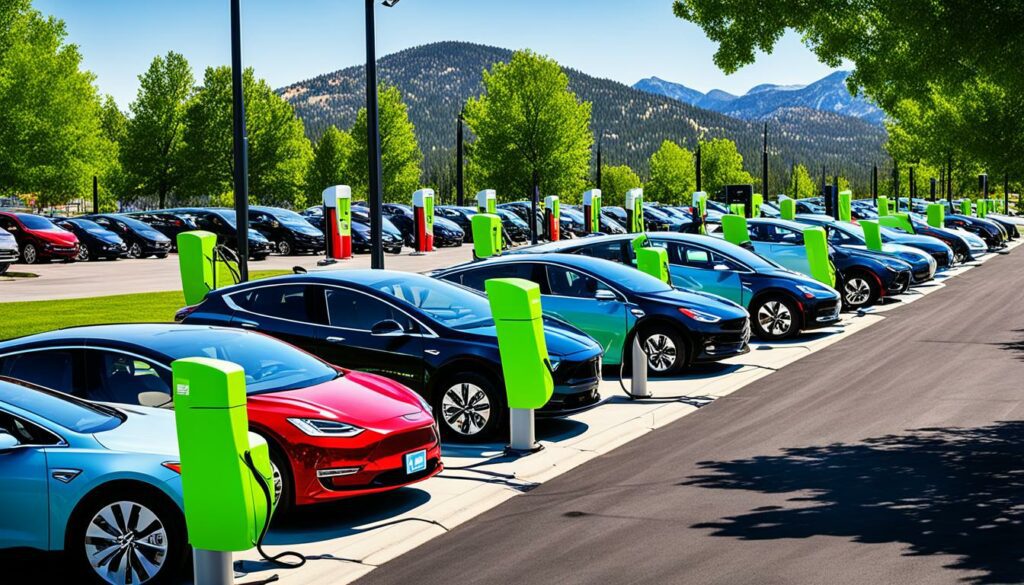
The increase in EV adoption is supported by a fast-growing EV charging infrastructure. The Bipartisan Infrastructure Law’s funding is key to expanding these networks nationwide. It ensures that as more people switch to EVs, the charging infrastructure is ready.
Over 20 countries have set plans to stop selling petrol and diesel cars in the next 10-30 years. This shows the world’s strong commitment to fighting climate change. California, for example, will require heavy-duty trucks to be zero-emission from 2024.
China is setting a high pace by banning some petrol two and three-wheelers in select cities. The world aims to have around 230 million EVs by 2030, according to the IEA’s Sustainable Development Scenario.
Expanding the EV charging network is vital to meet these goals. Governments are offering help through things like tenders and subsidies. These efforts push the growth of EV infrastructure forward.
But, making EV charging both effective and accessible everywhere is still a challenge. Achieving this will make more people consider an EV. It’s a crucial step in cutting down CO2 emissions from transport.
The future looks bright with more EVs on the road and a stronger charging network. This change marks a big step towards a more sustainable transport sector.
Utility-scale renewable energy projects are key to the US meeting its climate goals. They make a huge impact by helping produce cleaner energy and lower greenhouse gas emissions. States that are doing well use a mix of rules (like RPS) and money help (like tax breaks and grants) to back these big projects.
Such projects are changing how we get our energy and making it more sustainable. They follow special rules and get good deals, like FITs that pay a certain amount for every kilowatt-hour produced. Things like the ITC which gives a big tax break, and MACRS, help cut costs for building them.
“The Department of Energy aims to decrease costs for utility-scale solar from 4.6 cents per kilowatt-hour (kWh) in 2020 to 2 cents/kWh by 2030.”
But, these projects also face challenges, like long wait times for permits and some people not wanting them near their homes. To help, making the rules and getting the permission simpler is a good idea. Also, by supporting new power lines, which can help fit these projects into the energy grid, we can make it easier to use their power.
States are leading the way by making laws (like RPS) that push power companies to use more green power. This not only makes power rules cleaner but also helps the switch to green power happen in a smart way. Laws like PURPA, which says power companies must buy power from certain renewable sources, have really helped more solar power happen.
As solar power gets cheaper and as new rules help, these big projects will grow more. This will help the country move towards using more green power in a strong, step-by-step way.
| Policy | Description | Impact |
|---|---|---|
| Feed-In Tariff (FIT) | Guarantees payment in dollars per kilowatt-hour for the full output of the system for 15-20 years | Enhanced financial viability of renewable projects |
| Solar Investment Tax Credit (ITC) | Offers a tax credit of up to 26% for solar projects | Reduces upfront costs, increasing appeal for developers |
| Renewable Portfolio Standards (RPS) | Mandates increased energy production from renewable sources | Drives adoption and integration of renewable energy |
Renewable Portfolio Standards (RPS) have changed how the U.S. looks at renewable energy. They forced utilities to add more renewables to their energy mix over time. By November 2022, 36 states and the District of Columbia set these standards or renewable energy goals. This action helped boost the U.S. renewable energy market, reaching $269 billion in 2022.
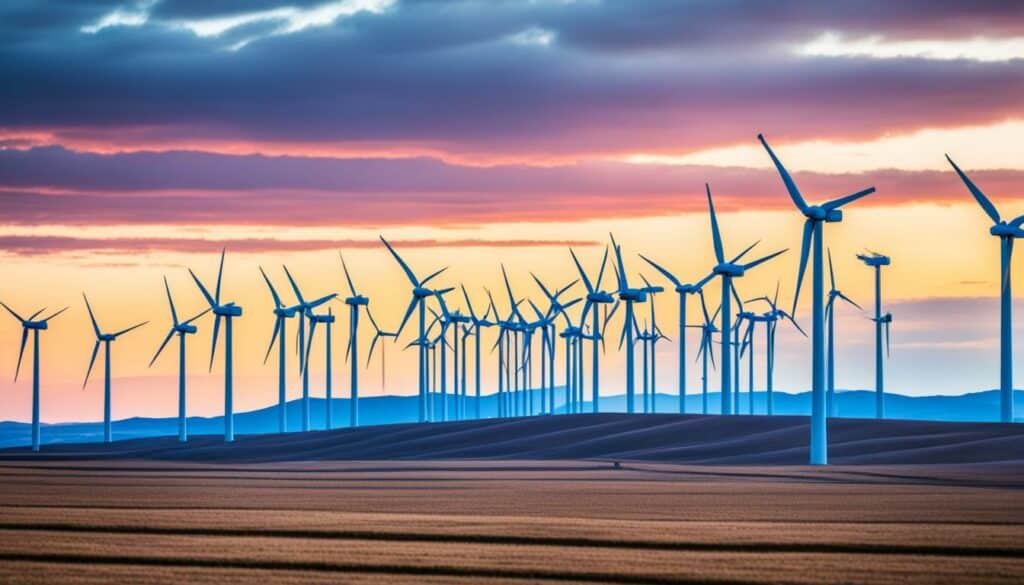
RPS played a key role in boosting renewable energy by roughly 50% in the U.S. since the early 2000s. States with RPS have usually met their targets, leading to more renewable electricity. The REC trading system also made it cheaper for utilities to follow these rules.
Cost caps were added in 20 states and Washington, D.C., to stop bills from rising too much. These policies helped add 23% of the U.S.’s renewable electricity between 1998 and 2019. Their impact on the U.S. energy framework is clear.
Some states have shown remarkable success with RPS, like California and New York. California aims for a 100% clean energy future by 2045, just like Washington, D.C., Puerto Rico, and Guam. This goal sets a high standard for others to aim for.
New York is also doing well, thanks to strong policies that attract investments in renewable energy. These states prove that with the right renewable standards and laws, big progress in clean energy is possible.
| State/Territory | RPS Target | Remarks |
|---|---|---|
| California | 100% clean energy by 2045 | Leading in solar and wind installations |
| New York | 100% clean energy by 2040 | Strong investments in offshore wind |
| Washington, D.C. | 100% renewable by 2032 | One of the most aggressive targets in the U.S. |
| Puerto Rico | 100% renewable by 2050 | Focused on increasing solar capacity |
| Guam | 100% renewable by 2045 | Investing in energy storage solutions |
States in the US lead various environmental energy initiatives to push for clean power. They do this by setting standards on car emissions and requiring clean electricity. They aim to fight climate change and grow the green energy field.
Right now, 30 states, Washington D.C., and two territories have made laws on clean and renewable energy. This shows strong support for state-level renewable energy initiatives. Since 2018, 19 states and some territories have even made their goals for clean energy tougher. Each state makes their own plans to meet the country’s climate goals, considering their specific challenges.
“Since 2018, 19 states, two territories, and Washington, D.C., have enacted laws to raise renewable energy targets, reflecting a solid commitment to clean energy advancements.”
Places like Minnesota and Michigan have seen great results from their ambitious clean energy goals. Minnesota’s work to boost renewable energy is a big step in the right direction. Michigan has not only set tough targets but also seen more green jobs rise.
California and New York are also doing a lot for clean energy. These are examples of states that aim high in their green energy targets. Even though some states didn’t renew their goals, many are working towards being fully green by 2050. These efforts show how crucial state policies are to the whole country’s green shift.
Five states and the U.S. Virgin Islands are aiming for 50% or more in renewable energy. This is key for their vitality and long-term health. They make sure costs are kept low through smart policies. This keeps the effort going strong.
21 states and Washington, D.C., have built special supports into their clean energy laws. These help with new energy tech and push forward the green energy agenda for everyone.
Upgrading our power infrastructure is key. We need it to handle electricity from renewable sources well. The Bureau of Land Management (BLM) oversees a lot of land. It’s about 245 million acres on the surface and 700 million acres below.
In recent years, the BLM helped a lot. It permitted projects for wind, solar, and geothermal energy. These projects have really helped our national power grid.
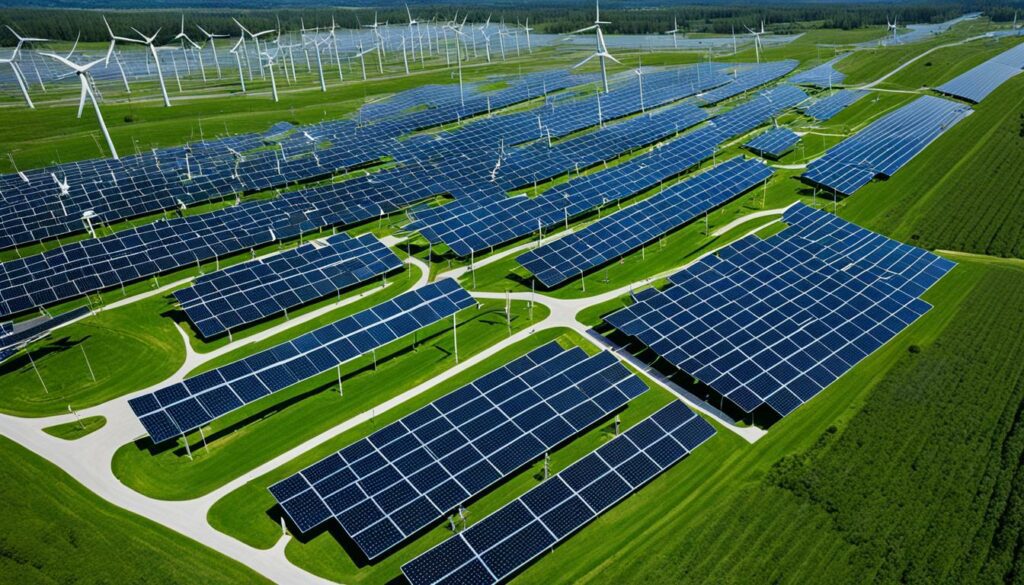
The past two years have seen lots of new energy projects approved. About 4,800 megawatts of energy were permitted. Most of this (about 2,650 megawatts) was approved in 2021.
As of October 2021, there were 34 solar projects and 36 wind projects on BLM land. That’s a total of 9,400 megawatts. There were also 47 geothermal power plants, adding around 2,500 megawatts.
However, we need to do more. We have to at least double our local power transport capabilities. Plus, we need to increase the power lines between areas by five. This is to meet our goals in renewable energy.
The rules the government makes are really important. They help with updates to our power lines and make our grid more reliable. The Federal Energy Regulatory Commission has passed a new rule. It makes it easier to choose where to build power lines. And, it helps share the building cost between states.
There’s also the Inflation Reduction Act, from 2022. It’s a law about climate and it helps clean energy. This law makes it easier to build power lines for renewable energy.
Big projects like the Southline and SunZia are working on moving clean energy between states. This shows how working together can help meet energy needs. Adding more long-distance power lines could save the U.S. a lot of money. It could save over $1 billion each year. Making our power grid better could also add 6.6 more gigawatts of clean energy in five states by 2027.
VPPs for managing peak energy times can help a lot. They can lower the need for new power structures. This lowers the cost for people, too.
| Project | Capacity (MW) | Investment | Homes Powered |
|---|---|---|---|
| Crimson Solar Project | 350 | $550 million | 87,500 |
| Southline Project | Information Pending | Information Pending | Information Pending |
| SunZia Project | Information Pending | Information Pending | Information Pending |
Moving completely to renewable energy will take a lot of hard work. It needs strong laws and good cooperation between the country and its states. This teamwork will decide how quickly we can improve our power system for renewable energy.
Overcoming supply chain challenges is key for renewable energy’s growth. The demand for green tech is high. Yet, getting parts worldwide brings big problems for project timings.
Supply chain issues hit project deadlines hard. For example, polysilicon, needed for solar panels, costs skyrocketed by 350 percent from 2020 to June 2022. This delayed making solar panels.
The cost of steel, copper, and aluminium, needed for wind turbines, also shot up. Booking ships 180 days ahead to carry wind farm parts is common. This led to major hold-ups in projects.
Dealing with these challenges needs smart solutions and strong policy backing. It’s vital to fix delays in getting key parts and in scarce raw materials. The Inflation Reduction Act in the U.S. helps by giving financial boosts to green energy projects.
Changing how we buy things is key, moving towards local production. Plus, using special carriers and cutting equipment breakage to 1% can boost project speed.
By focusing on these solutions and strong renewable energy policies, we can beat the current supply chain issues. Using new tech, looking for materials in more places, and working closely with others can make the renewable energy supply chain more solid. This will help meet our big green energy goals on time.
The world is shifting towards clean energy, but getting there is tough. High interest rates make financing expensive. This makes deals and projects harder to fund. It also adds pressure to the tight budgets of renewable projects, making investors worried.
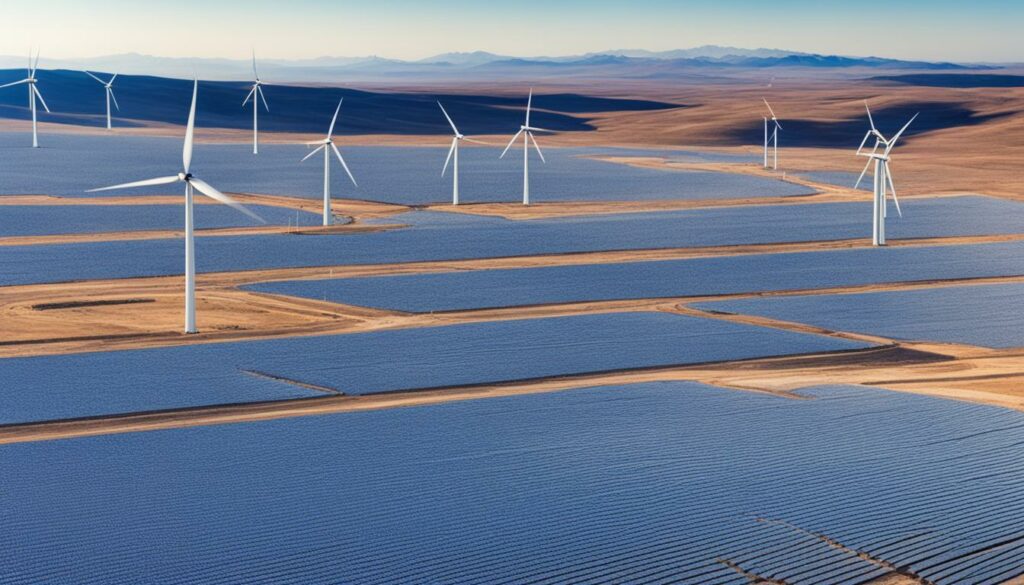
Rising interest rates shake the clean energy sector hard. It’s become harder to get funds for new projects. This slows things down and makes projects less financially sound. Materials’ costs and supply chain issues also make things complex.
“Nine out of ten respondents expect increases in the cost of capital in emerging and developing economies related to clean energy investments in 2023.”
There are ways to fight these tough financial challenges in clean energy. One way is to change existing power deals to more secure prices. Using renewable energy subsidies can also help. These steps cut costs and boost profits. It’s also smart to plan and push for policies that help. This approach can help clean energy grow sustainably, even with big financial hurdles.
Here’s a detailed table showcasing recent figures:
| Year | Solar Investments | Wind Investments |
|---|---|---|
| 2021 | US$420 billion | US$171 billion |
| 2022 | US$500 billion | US$162 billion |
| First Half of 2023 | US$358 billion | N/A |
In the end, the road to clean energy has many financial bumps. But with smart plans and using subsidies well, the industry can keep growing.
In recent years, clean energy manufacturing has advanced a lot. This improvement is worldwide, but the United States is leading. They do this by investing a lot and making smart moves.
Private companies have started new clean energy projects worth over $500 billion since January 2021. About $360 billion supports clean energy manufacturing, EVs, batteries, and power generation. This big push has set up three new Clean Energy Manufacturing Innovation Institutes and a special place for starting up clean energy businesses.
The recent Inflation Reduction Act and Bipartisan Infrastructure Law have helped a lot. Spending on building manufacturing sites has nearly doubled since President Biden began. Just in 2023, there was a big 27 percent increase. More than 100 gigawatts of solar module assembly capacity are planned, with 79 new places to make them. This shows over $13 billion in investments.
| Aspect | Projection |
|---|---|
| Solar Capacity | 338 gigawatts by 2030, nearly double the 2021 projections |
| Wind Turbine Capacity | 300 gigawatts by 2030, 43% increase from 2021 projections |
| Battery Energy Storage | On track to more than double in one year, nearly double again by 2024 |
| EV Sales | More than one million by 2023, surpassing 2021 projections by 18 years |
Looking forward, clean energy manufacturing will keep getting better. The U.S. expects to have 338 gigawatts of solar and 300 gigawatts of wind power by 2030. This is a lot more power. Battery storage will also increase a great deal. This growth will make our power supply more stable and reliable.
These steps are part of reducing our carbon footprint. They make sure we use energy better without harming the planet. Clean energy is not only good for the environment but also for creating jobs and growing our economy.
Federal and state governments working together are key to making progress in renewable energy. They use shared funds and policies to support various projects. This teamwork speeds up the use of renewable energy sources across the country.

A great example of this teamwork is a deal that gives clean electricity to federal facilities in 16 states by 2030. These efforts aim to increase the use of clean power from 38% now to 47%. The big goal is to hit 100% by the end of the decade. This partnership shows how different government levels working together can achieve big things.
The Department of Defense and Dominion Energy are also working together. They want to create clean electricity on-site and improve how they use energy. By working together, they are making their operations stronger and more secure through clean energy.
Although there have been successes, there are still ways to do better. Making sure rules and plans match up on different government levels is very important. This can make things smoother and faster for setting up renewable energy projects.
It’s also crucial to get everyone involved interested and informed. This means talking openly and getting ideas from the community and companies. By doing so, these partnerships can get stronger. They can meet their big sustainability goals more effectively.
The United States is charging towards a greener future. This journey is powered by huge steps in renewable energy and technology. These shifts aim to cut carbon footprints, reduce our need for oil, and make our economy stronger.
The Northwest mostly uses coal and water for power. But it has big chances in wind and underground heat. If the region uses more wind and geothermal power, it could make electricity cheaper. This also means a more eco-friendly and economically sound energy plan.
States are key in making this happen. Places like Idaho and western Montana have lots of wind energy potential. State-driven plans and rewards help a lot here.
The discussion around the Kuznets curve and environmental impact is deep. But with clear laws and support, the move to greener energy is steady. We must keep pushing for these green laws. This way, our efforts today will build a cleaner, greener tomorrow.
Renewable energy policies are rules and incentives to boost green energy. They include solar, wind, and battery power. These policies help cut pollution and grow our economy. They also make us less reliant on others for energy.
These policies are key for making more use of green energy. They reduce damage to the environment. Plus, they encourage investing in clean energy. This helps us move to a less polluting economy.
In the US, laws like the Inflation Reduction Act and the Bipartisan Infrastructure Law have brought big changes. They support investing in clean power like wind and solar. Plus, they help solve problems with buying parts and getting money for projects.
Last year in the US, solar power hit a big milestone with 31 gigawatts added. This made up about 5% of the electricity. Yet, getting parts and dealing with trade rules are still challenges to tackle. Keeping up the good work means dealing with these issues.
Batteries are crucial for keeping the energy grid stable and reliable. By 2024, we expect to have twice as many batteries thanks to laws like the Inflation Reduction Act.
Wind energy is growing fast in the US. By the end of last year, we already had 147 gigawatts. More efficient wind power is on the way with new support.
Electric cars are becoming more popular than ever. 2023 saw a big jump in the number of EVs sold. The US is also making more places to charge them, thanks to laws like the Bipartisan Infrastructure Law.
Big renewable energy projects get help from policies like Renewable Portfolio Standards. These and other financial perks help deal with the costs and rules. They are essential for reaching our climate goals.
RPS makes power companies use more clean energy. This pushes them to invest in green technology. Some places have done so well that they’ve gone beyond their targets.
States are leading the charge with rules that demand more clean energy and cleaner car standards. Places like Minnesota and Michigan show that state efforts really matter for our national goal of using more clean energy.
Making the power grid better is a big step for more green electricity. But the work going into it is not happening fast enough. Both federal and state plans are needed to fix this so we can use more renewable energy.
Delays in getting parts because of supply chain problems are making it harder and more expensive to build green energy projects. Acts that encourage investment aim to fix these issues by supporting new solutions.
More expensive loans are making it hard for clean energy projects to go ahead. Project managers are trying new ways to keep costs fair and stable. This includes talking over the prices for building and running these projects.
A lot of money from the Inflation Reduction Act is going into making green tech. This includes new factories and expanding our own ability to make clean energy gear. This lessens how much we need to buy from other places and makes more jobs here.
The central and state governments are working as a team with money plans and laws to speed up green projects. This teamwork is good but we still need better ways to work together and talk to each other about these plans.